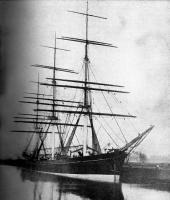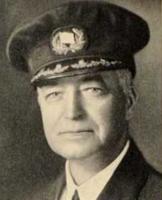
Ship British Isles
What is history? What is fiction? These seem to be straightforward questions. The conventional answer would be that history is what happened and fiction are the stories that we make up. In writing my recent novel I was faced with these questions and have come away with only more questions. My novel, Hell Around the Horn, is based on an actual voyage of the British windjammer, British Isles, from Cardiff, Wales to Pisaqua, Chile in the the terrible Cape Horn winter of 1905. Unlike most windjammer voyages of the late 19th and early 20th centuries, the 1905 voyage of the British Isles was very well documented. And that is where the troubles start.

Captain James Barker 1934
James Barker, the captain of the ship, sat down and with the help of his son, Roland, wrote his memoir, Log of a Limejuicer, in 1936. Close to half the book is focused on the 1905 voyage. Then in 1956, William Jones, who had been a first voyage apprentice on the voyage wrote his own account of the trip, the Cape Horn Breed. Then in 1970, the sailing ship captain and author, Alan Villiers discovered what he referred to as a “treasure trove” of old ship’s logs and other documents in crates in a Royal Air Force hangar, about to be thrown away. He rescued the logs and finds the original “Official Ships Log and Articles of Agreement” for the ship, British Isles, for the 1905 voyage, as well as many other sailing and motor ship logs for that period. Villiers was so taken by the accounts of ships rounding Cape Horn during that brutal winter, that he writes a book about it. Villiers’ War with Cape Horn comments extensively on the voyage of the British Isles as well on Captains Barker and Jones accounts of trip.
What could be better? I had three primary sources for information about the voyage – the original ship’s log, written by Barker in 1905; his memoir and the memoir of the apprentice William Jones. Add in the commentary of Villiers, an experienced Cape Horn sailor and sailing ship captain. The package was complete. Indeed, one might ask why write a novel about a voyage which was so well documented?
On reading the three “factual accounts,” however, it is obvious that while each is describing the same ship on the same voyage, they each differ in critical areas. Fundamental facts, such as how many and which crew members died on the voyage do not agree between the log and the two memoirs. Each has a different tally of the deaths. Crew names, the number of apprentices and other significant events all differ between the three accounts. Among other things, Captain Barker never mentions Apprentice William Jones in his book, which may have goaded the then Captain Jones to write his own account later in life. Jones is listed in the Official Log and and also produces a letter of commendation written in Captain Barker’s hand for Jones’ service on the ship.
Villiers comments on the discrepancies (War with Cape Horn, page 56) : The facts become difficult to get in order. Captain Barker wrote (by dictation to his son, apparently) his own account in the “Log of a Limejuicer” more than a quarter of a century afterwards and at times gets the facts so wrong that it would almost appear deliberate.
Captain Jones produced his account at least twenty years after that: this is loyal to his captain (as every apprentice should be) but varies considerably from his own yarn and perhaps at times give the discerning reader a better picture than intended. (So does Captain Barker, of himself.)
In both cases, the memoirs tell the stories that each captain wanted to be told. I suspect that Roland Barker, who took down his father’s account, was more a simple amanuensis. Roland would go on to write novels on his own. My speculation is that he might have assisted in taking liberties from the facts in order to make a more exciting story. Captain Jones claimed to base his account on a diary that he kept on the voyage. Nevertheless, he admitted that his penciled in notes on some pages had been washed away by the sea, so he had to rely on his memory for parts of his tale.
The only thing certain about the three “factual” records of the voyage was that at least two contain considerable amounts of fiction.
Beyond the question of what actually happened, even when Barker and Jones wrote of the same events, the perspective was, of course, very different. The ship and the world as a whole looks different to the captain on the poop deck than it does to an apprentice in the half-deck.
This is one of the reasons why I decided to write the novel. What actually happened on the voyage was open to interpretation and how one saw and understood what happened also depended on where one stood on the ship. Rather than have the story told through a single set of eyes, I used four different characters – Captain Barker, his wife Mary, Apprentice Jones, and an American sailor before the mast, Fred Smythe. The first three are based on the actual people who sailed on the British Isles. The fourth was inspired by Fredrick Pease Harlow, an American sailor in the 1870s. My intention was to try the capture the larger story of the remarkable men and women on the voyage by reflecting the various points of view aboard the tiny community on the sailing ship.
A word about Fred Harlow. He also wrote a memoir, The Making of a Sailor or Sea Life Aboard a Yankee Square-Rigger. It tells the story of how Fred’s father, who opposed him going to sea, arranged a trip as crew on a coastal schooner for the young man. Fred’s father asked the schooner captain to go rough on his son in hope of dissuading him from future sailing. Fred, however, did well on the schooner and then shipped out on a Yankee Cape Horner for a voyage to Australia and and Indonesia.
When Harlow died, years after his memoir was published, his papers were donated to Mystic Seaport Museum. Only then did the truth come out that Fred’s first voyage was to Australia and only then did he sail on a coastal schooner. It seems that Fred rearranged events as he saw fit to improve the story. A biographer said that this made Harlow “more than just a simple chronicler” but that he was instead “an artist.” To which I say, nonsense. Fred was a sailor telling a sea story. And there is nothing wrong with that.
Napolean said that “History is a set of lies agreed upon.” I would prefer to think that history is just a set of sea stories, told and retold.
My next novel is inspired by a character from Fred Harlow’s memoirs. Set on a medium clipper in the 1870s, it has the working title, The Shantyman.
Writers aboard the Blog Hop – do please pay them all a visit!
- J.M Aucoin
- Helen Hollick
- Doug Boren
- Linda Collison
- Margaret Muir
- Julian Stockwin
- Anna Belfrage
- Andy Millen
- V.E. Ulett
- T.S. Rhodes
- Mark Patton
- Alaric Bond
- Ginger Myrick
- Judith Starkston
- Seymour Hamilton
- Rick Spilman
- James L Nelson
- S.J. Turney
- Prue Batten
- Antoine Vanner
- Joan Druett
- Edward James
- Nighthawk News

‘Hell Around the Horn’ tells an extraordinary voyage. The struggle to double the Horn is the best I have ever read. I look forward to more similar nautical novels from Rick Spilman.
Fascinating that line between fact and fiction. Looking forward to more late nineteenth century sailing adventures!
Wow what a terrific site. I have been an hand on Capt Mike Burke’s Windjammer Cruises in the 1970’s. Recently I have been marketing Charters on The Schooner Western Union, Key West’s and The State of Florida’s Flagship. I am a sailor and I am surrounded by sailors all the time. I will be reading your blog and turning my friends on to it. Thanks
Bobbyb
Your Friend in Key West.
Every work of fiction must be based, at least rudimentally, in the ‘real world’ otherwise it would be unintelligible. Animal stories are not about animals but humans in animal skin. The aim of fiction is not to get the so-called facts right but to get at the truth of the story. The truth is the interaction between human beings. There have been many so-called non-fiction books about Ferdinand Magellan over a few centuries. The ‘facts’ alter over time as new evidence is uncovered. I have written a book about Magellan’s famous voyage (A Singular Captain) that would have to be called historical fiction because I put words into people’s mouths but I believe the fictional account is more true than any number of academic tomes claiming to present ‘facts.’